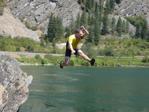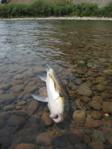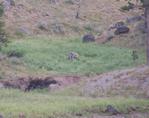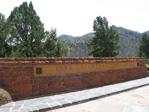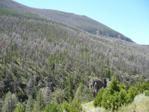After a day in Sheridan (where we talked at a library and spent half an hour in an interview on the morning talk radio), Bill and I climbed into the Big Horn Mountains, thus officially entering the Rocky Mountains. The 5,000 ft climb brought cooler temperatures, pine forests, and a great descent when we reached the far end of the mountains.
Riding across more dry rangeland, and spending one day in Cody, WY, we climbed again, this time into Yellowstone National Park. Yellowstone is a high volcanic plateau covered with evergreen trees and abundant wildlife. We saw elk, bison, eagles, osprey, and—to our surprise—even a wolf (see photo below & far right). As none of the wildlife is hunted, the animals approach cars and people, resulting in frequent bison traffic jams. (A ranger told us not to approach the bison on our bicycles — which turned out to be pretty much impossible as the bison would walk across the road both in front of and behind us.)
I was also struck by the number of large cars and large RVs (many of the RVs had large SUVs in tow). Everyone was driving to see the wildlife and features of the park, and likely enjoying great road trips.
I must admit, though, that it is hard to see so much gasoline use, knowing what effects global warming will have on this region.
What does global warming mean for Yellowstone? Well, for starters we think forest fires may be five times more common in this part of the country, as drier and hotter summers cause fires to burn hotter. In addition to reshaping the natural environment, there is another cost — entering the park we saw a memorial to 12 firefighters who died fighting a forest fire.
Secondly, we have seen lots of dead trees in the mountains from another source — bark beetles, which burrow into the bark of trees and kill them in large numbers. Descending out of the Bighorn Mountains, an entire mountainside appeared to be dead (photo left). Outbreaks of these beetles have become more common in recent years, as warmer temperatures have helped them reproduce faster and reach higher altitudes. As the earth warms, we are likely to see pests like these to spread in places we have not seen before.
And finally, we just read an interesting piece in a local paper — fishing in this region has had to be restricted, as an unusually hot summer and low water flow has caused fish die out in the Yellowstone region. More summers in the future will be like this, which raises questions for future sport fishing in in this region.
All of this points the same way — warming the earth will seriously and irreversibly change natural systems. These are examples of why we think we may loose as much as 20% of all known plants and animals to extinction if continue with business as usual.






